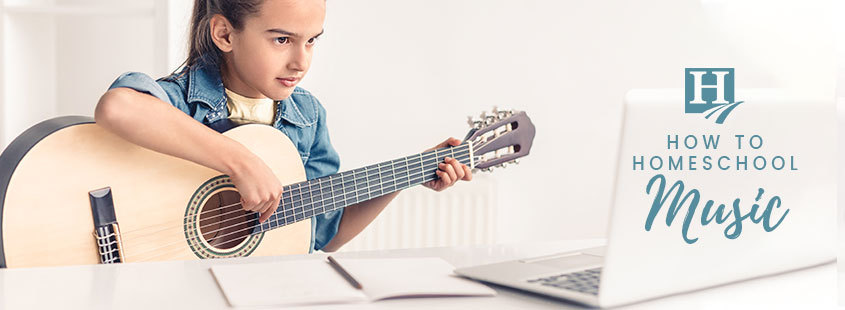Music is a wonderful outlet for children and adults alike. Learning how to play an instrument or sing has proven benefits for students, and can enhance their skills in other subjects. Not every homeschooled parent has musical talent, though.
Thankfully, there are several options for homeschool music lessons.
Music lessons can fit many preferences, whether you are looking for a class setting, private, or virtual. For example, students can take homeschool music lessons privately from professionals, at a community college, in a university program, or, occasionally, even at a local high school. Additionally, homeschool co-ops are usually buzzing with music opportunities for homeschooled students.
In homeschool support groups, fellow parents may offer private lessons, and sometimes older teenagers are looking for students to build their experience!
However, before we discuss how to teach homeschool music, let’s explore the common styles of lessons. As an elective, music likely offers the most variety.
Types of Music Lessons to Consider
When beginning a fine arts study, it helps to examine your goals for your child’s experience. Whether you teach the homeschool music lessons yourself or you’d rather your child join a co-op class, knowing about the different methods is helpful.
Your child’s learning style will make all the difference for success.
With the correct approach for your family’s goals and your child’s learning style, they will undoubtedly have a well-rounded music education!
Four Popular Teaching Methods for Music:
When looking for homeschool music lessons, know that instructors may believe the best approach for well-rounded education is either adhering strictly to one teaching style or mixing multiple methods. Either way, music teachers are typically passionate about their choice.
Research your options, familiarize yourself with the most common teaching methods, to determine the best for your child.
You may have to try a few teachers before you find the correct fit.
We’ve all been there. In the end, your child’s success is most important. The ability to switch teachers and methods is a unique benefit of homeschooling!
- The Orff Approach. This method focuses on elements of play integrated with other visual arts (dance, acting, singing). This approach features four stages: imitation, exploration, improvisation, and composition.
- The Suzuki Method. This method began in Japan and the U.S. discovered it in the 1960s. Violins were the first instrument taught with The Suzuki method. However, piano, guitar, and flute lessons all fit within the method as well. An immersive experience is the basis for the Suzuki method, in which a child learns their native language.
- The Kodaly Method. With the Kodaly method, students work through sequenced and progressive lessons until they naturally transition into mastery of ear training and sight-reading. In this method, an essential component is singing.
- Dalcroze Eurythmics. This teaching method combines movement, ear training, and improvisation. Teaching music by engaging the tactile, aural, auditory, and visual senses is an important foundation for the Dalcroze method.
Studying music positively impacts learning development, focus, creativity, concentration, and more.
As parents, we encourage our children to enjoy their music lessons. There are many merits to homeschool music lessons, beyond enjoying the instrument.
Eight Benefits of Learning Music:
- Improves fine motor skills
- Develops coordination and gross motor skills
- Strengthens muscles and posture
- Requires patience and persistence
- Boosts self-esteem
- Introduces other cultures and societies
- Strengthens social skills (namely in group classes)
- Improves math skills (many similarities exist between math and music)
How to Start Homeschool Music Lessons
Most parents with previous music knowledge have learned from either band class, a how-to workbook, or a strict teacher with traditional lessons and 60 minutes of daily practice.
When your child mentioned music lessons, perhaps these memories swam through your mind. Today, there are many more avenues for homeschool music lessons.
First, here are several, incredible, online options for homeschool music lessons!
Second, here are more teaching ideas and where families can find music teachers!
- Local Music Shop. Local shops often employ passionate musicians to offer lessons!
- Homeschool Co-op. Co-ops often offer several music class opportunities, one-on-one lessons, or group recitals.
- Parent Teachers. Parents often volunteer their skills by teaching lessons and theory to homeschooled students in the co-op, typically providing a developed music program.
- Student Teachers. If you are homeschooling on a budget, ask around the homeschool group to see if any older teenagers are looking for students. These students often have reduced rates while they build their experience.
- High School Band Class. If your state permits it, students can join their local high school band for a classroom experience.
- University Classes. Whether with dual enrollment or regular courses, high school students can join music classes and groups at community colleges or universities.
- Online Independent Learning. A guide for self-teaching may be all your child needs! Older students especially may do well with virtual instruction from YouTube videos or online courses.
- DIY Homeschool Music Lessons. Musically-inclined parents could teach their own children! Teaching your children is challenging and perhaps even intimidating, but it’s a realistic option if you already play an instrument.
More Information About Music for Homeschoolers
- How to Homeschool Art
- Hand Exercises for Children Learning Music
- Understanding Basic Music Theory
- Homeschool Music Association
- Is Music a Language?
- Danman’s Music Library
- What is Your Child Trying to Say About Music?
- Beginning Band Course
- Classroom Recorder Course
- Free Online Courses from Berklee College of Music
- Musicards
- The Magical Mathematics of Music
- Free Lesson with Lessons With You




